Most cooking recipes are formulated improperly: they list actions required to prepare food, but fail to explicitly mention which of those actions can be run in parallel. This leaves you guessing how much time you could save if you added a pair or two of spare hands to the cooking process, thereby reducing your “time-to-dinner”.
Today we will explore the cooking process for Hungarian Goulash, using a mix of these two recipes: 1, 2.
To do the theoretical part of our research, we will use Gantt charts to represent tasks that can proceed in parallel; this convenient tool is widely used in project management. I used “Planner”, a free software which is suitable for some (very) simple planning purposes.
Here is the list of tasks to be performed and their duration in minutes (I had to enter them as days):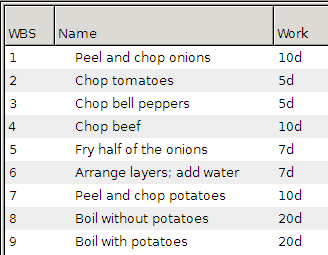 First, we will prepare a Gantt chart for the case of “serial execution”, that is, when you are the only cook in the kitchen:
First, we will prepare a Gantt chart for the case of “serial execution”, that is, when you are the only cook in the kitchen:
 As can be seen, there is some overlap in tasks even though you are cooking alone: for example, you can put chopped onion into the Dutch oven and let it fry (item 5) at the same time (i.e., in parallel) as you chop beef (item 4). Similarly, while the dish is boiling (item 8), you can peel and chop potatoes (item 7). All in all, it takes 77 minutes if you are cooking alone for a herd of hungry people.
As can be seen, there is some overlap in tasks even though you are cooking alone: for example, you can put chopped onion into the Dutch oven and let it fry (item 5) at the same time (i.e., in parallel) as you chop beef (item 4). Similarly, while the dish is boiling (item 8), you can peel and chop potatoes (item 7). All in all, it takes 77 minutes if you are cooking alone for a herd of hungry people.
Now, let us rearrange tasks to model the situation of unlimited parallelism — when you have lots of guests who are trying to help and offer their chopping skills:
The maximal degree of parallelism — in other words, the maximal number of people cooking at the same time — is equal to the maximal number of bars overlapping at any given moment. In this algorithm recipe it equals four; adding more people will not help to speed up the process. (Update: Not quite — the above assumes that chopping tasks cannot be split further. In fact, chopping takes 30 man-minutes (10+5+5+10), and you can assign it to, say, 30 persons, and they may complete it in one minute, further reducing cooking time. This valuable insight was provided by Jonas; see the comments section below).
Also, the four people are only required in the very beginning of the cooking process when everyone is chopping their part of food (items 1 through 4); you can dismiss your three helpmates afterwards. The overlap in items 7 and 8 doesn’t require someone else’s help; it is the same as in the serial case.
Now, the process takes only 64 minutes instead of 77. Not only it is faster, but you also: (a) occupied your guests so they do not sit idle feeling abandoned; (b) demonstrated compelling leadership skills; and (c) tried some project management right in your own kitchen. Sheer benefits!
If you are curious how it went for me and my friends, here are some photos. The mistress of the house studied in Hungary and told us that the result quite resembles what she ate in Budapest. Remember, we start with chopping everything:
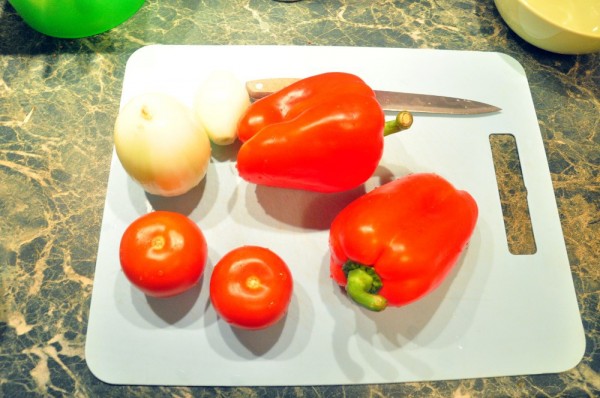 Next, cut the beef and prepare the spice, of which the most important one is the sweet variety of paprika:
Next, cut the beef and prepare the spice, of which the most important one is the sweet variety of paprika:
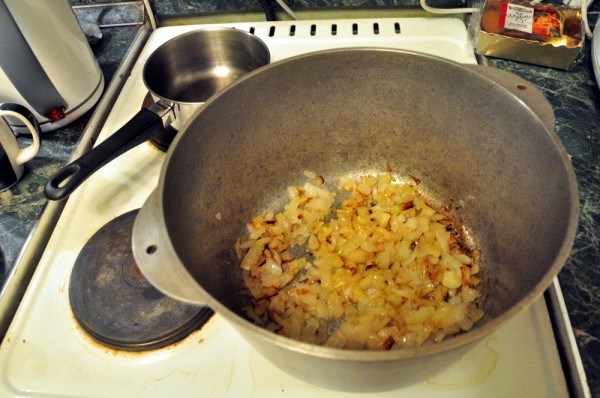 Arrange beef and vegetables in layers:
Arrange beef and vegetables in layers:
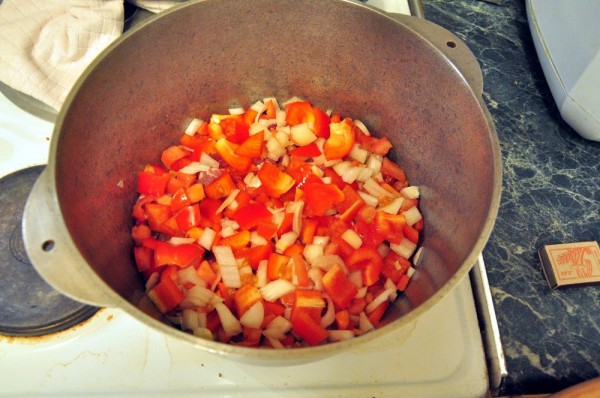 Add sweet paprika and caraway seeds. Caraway is not to be confused with cumin, which is the plant of the same family but with a slightly different taste (the family name is Apiaceae and it also includes parsley and carrots!)
Add sweet paprika and caraway seeds. Caraway is not to be confused with cumin, which is the plant of the same family but with a slightly different taste (the family name is Apiaceae and it also includes parsley and carrots!)
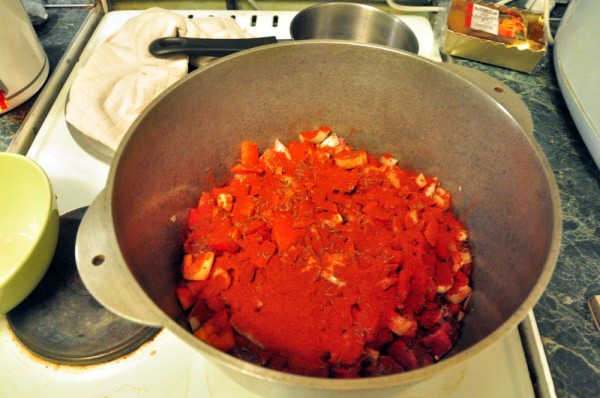 Cover with boiling water. I added some tomato paste for even more red colour; remember though that it also adds sour taste, so consult your inner dietitian whether it is desirable:
Cover with boiling water. I added some tomato paste for even more red colour; remember though that it also adds sour taste, so consult your inner dietitian whether it is desirable:
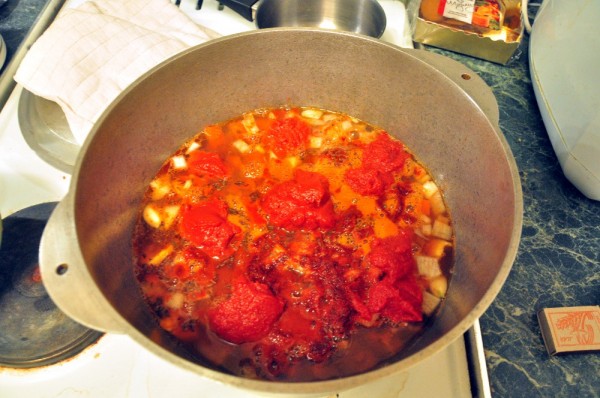 Stir just a bit (I also added laurel leaves), cover with a lid and bring to a boil:
Stir just a bit (I also added laurel leaves), cover with a lid and bring to a boil:
 The rest is simple: cook for 20 minutes under the lid, add chopped potatoes and cook for another 20 minutes. That’s how it looks like when served:
The rest is simple: cook for 20 minutes under the lid, add chopped potatoes and cook for another 20 minutes. That’s how it looks like when served:
 Enjoy your meal! And vote for politicians who promise to bring cook-books into order by prohibiting recipes that don’t explicitly describe parallelism!
Enjoy your meal! And vote for politicians who promise to bring cook-books into order by prohibiting recipes that don’t explicitly describe parallelism!


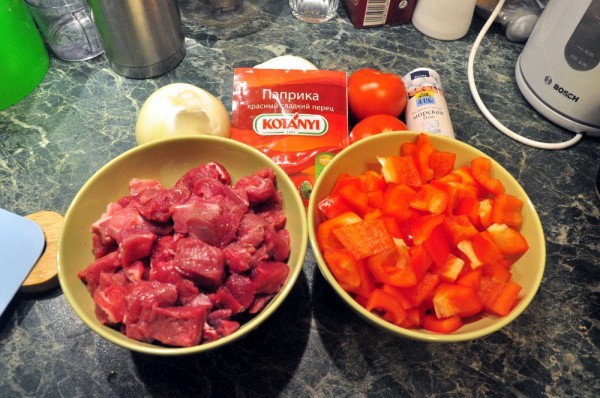
First of all a very amusing usage of parallelism!
The chopping can be further parallelised if e.g. the onions are split in two portions, chopped by two persons.
So 30 persons could get the chopping done i one minute, shaving another 9 minutes of the process time.
Unfortuantely this approach leaves us with a lot of dishwashing not taken into account.
So perhaps we should just stick with splitting the onions and beef into two portions and saving 5 minutes :)
Good thinking, Jonas — I missed that we can split chopping into infinitesimally small chunks. I updated the blog post to reflect your approach.
> So perhaps we should just stick with splitting the onions and beef into two portions and saving 5 minutes :)
It seems optimal, indeed. It will provide enough work to entertain six amateur cooks at the chopping stage, although only for five minutes.